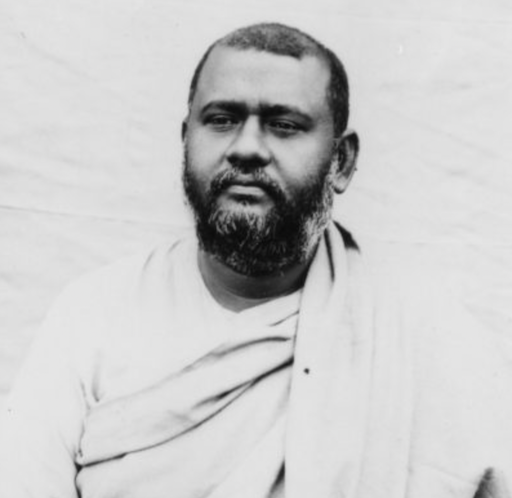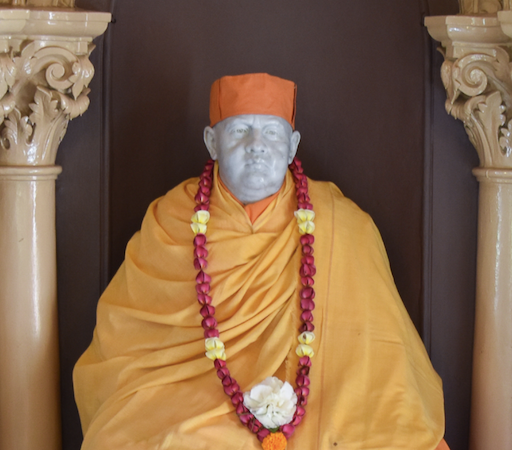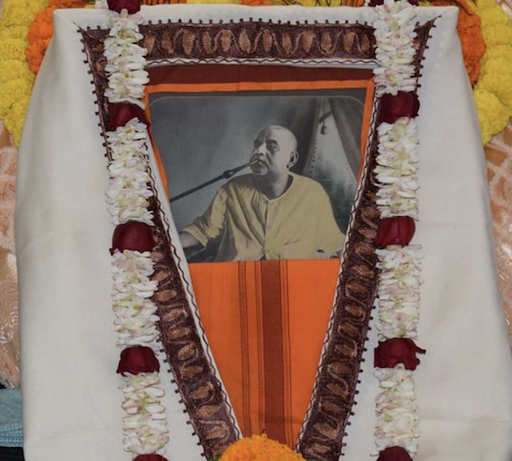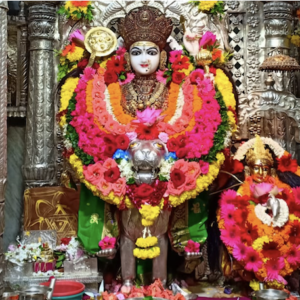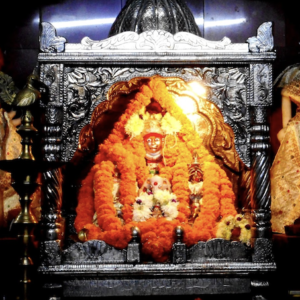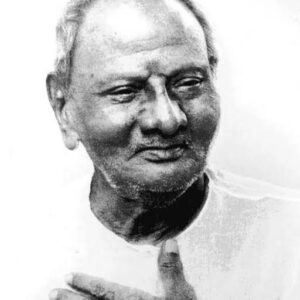This is a temple at a place where Swami Brahmananda was cremated at Belur Math. The math also contains the temples with remains of Sri Ramakrishna, Sri Sarada Devi, & other disciples of Sri Ramakrishna.
There is a place to sit and meditate. You can go into meditative states here effortlessly.
How to Get there
The temple is located 300 m East of Belur math station.
Map:
https://maps.app.goo.gl/spTyVpSdcdEagopL9
Birth and Early Life
Rakhal Chandra Ghosh, the name by which Swami Brahmananda was known in his pre-monastic life, was born in an aristocratic family in a village not far from Basirhat in the district of 24 Parganas. His father Ananda Mohan Ghosh was a zamindar. His mother was a pious lady and a devotee of Sri Krishna. Perhaps it was she who gave her son the name Rakhal (meaning the boy-companion of Sri Krishna) when the latter was born on 21 January 1863. Unfortunately, the mother died when Rakhal was only five years old. Soon after, his father married a second wife who brought up Rakhal.
As a student, Rakhal was remarkable for his intelligence. But even as a boy he had varied interests in life. Physically he was much stronger than the average boy of his age. His companions found it hard to cope with him in wrestling or at play. He would take part in many village games and show unsurpassed skill in them. But play and games did not absorb the whole of his attention. Nearby was a temple dedicated to the Goddess Kali. Often enough, Rakhal would be found in the precincts of the temple. Sometimes he would play at Mother-worship along with his companions. Sometimes he would himself make a beautiful clay image of the Mother and remain absorbed in worship. Even at an early age, Rakhal had a great devotion to Gods and Goddesses. During the time of Durga Puja in the family, he would be found seated still and calm witnessing the ceremony, or at the hour of darkness, when the evening service was being performed, Rakhal would be seen standing before the Deity in great devotion.
After completing his primary education, Rakhal was sent to Calcutta in 1875 and was admitted into an English High School. In Calcutta, he came in contact with Narendranath, afterwards known as Swami Vivekananda, who was the leader of the boys of the locality. Narendra, with his dynamic spirit and inborn leadership, cast his influence over others and carried them along the path he thought right. Rakhal, meek, quiet, and soft-natured as he was, easily came under his spell, and there grew a close friendship between the two which culminated in common discipleship at Dakshineswar and bore far-reaching results.
Rakhal and Narendra practised physical exercises in a common gymnasium along with their other companions. And it was Narendra who took Rakhal to the Brahmo Samaj, where they promised not to worship any image. Rakhal’s inborn religious tendencies began to unfold themselves more definitely at this stage. He would be found brooding over the mysteries of life and death, and his mind longed for the realisation of the Eternal Verity.
Beginning of Monastic Life
We have it from Swami Ramakrishnananda that it was during the lifetime of the Master that one-day Swami Vivekananda, or Narendranath as he was then called, came and said to Sri Ramakrishna, We have made Rakhal our king (Raja). Then addressing his brother-disciples present, he said, He is our king, you fellows are his subjects – at which Sri Ramakrishna expressed great satisfaction. From that time forward Swami Brahmananda has been called by his Gurubhais as Raja, and latterly as Maharaj, and in the Ramakrishna Order, he was known by this distinctive title and, out of respect, never mentioned by name. Swami Ramakrishnananda also said None of us mixed with Sri Ramakrishna as intimately as he did. The Master always looked upon Swami Brahmananda as his spiritual son, sent specially by the Divine Mother to take care of his body. Consequently, he allowed the Swami privileges that were vouchsafed to none else. He took Maharaj on his shoulders and often did Maharaj lie resting his head on Sri Ramakrishna’s lap. During this period of intimate association, Sri Ramakrishna trained his favourite boy for the great mission he was to fulfil in future. Besides making him undergo various spiritual practices under his direct guidance, equipped him also with a rare amount of secular knowledge which later on enabled the Swami to be equal to any occasion, and lent that remarkable versatility to his genius.
For example, the Master instructed him how to judge a person’s character by sight, and everyone knows how through this insight he could tackle with consummate skill the multifarious problems arising in connection with the individual and collective welfare of the Brotherhood of which he was the Head and of the numerous lay devotees who sought his advice a11d guidance-secular as well as spiritual. Nature had endowed him with another fascinating element in his character, namely, his childlike simplicity. We have, from the authority already quoted that on one occasion Sri Ramakrishna was so much struck with this trait of his, that he burst into tears as he said, You are so simple! Ah, who will look after you after I am gone! It was gratifying to note how this affectionate solicitude of Sri Ramakrishna was responded to by everyone taking the utmost care of the Swami throughout his life. In the prophetic words of the Swami Vivekananda:
The Divine Mother writes with Her hand on the forehead of people of such spiritual stamp that all nature must honour them, and nature instinctively obeys!
After the passing away of Sri Ramakrishna in 1886, Swami Brahmananda spent over six years outside the Math practising Sadhana and leading a wandering monk’s life, mostly accompanied by a brother-disciple. During this period he visited many holy places of Northern India and went as far as Dwarka in Kathiawar. Thus he had the opportunity to get firsthand knowledge of the condition of the country and the infinite variety of beliefs and opinions that obtain in this miniature continent. Though accustomed to. The comforts of a luxurious life from his birth, for he was the son of a Zamindar of Basirhat in the district of 24- Parganas, he showed a wonderful adaptability to the new life of renunciation he had cheerfully embraced at the call of Sri Ramakrishna, and took no thought for physical necessities, intent all the while on the realization of the highest truths of religion which alone he ever considered as the supreme goal of human aspirations. Sri Ramakrishna had detected the sterling qualities of his pupil’s mind and described him in the following glowing terms.
He is a Nitya-Siddha, an Isvara-Koti. He belongs to that class of exceptional personages who have already finished their course of Sadhana and realized the Goal in some previous birth, and whose spiritual practices in this life are superfluous, being simply to re-discover their past realizations Their advent on earth is for teaching mankind. These pure souls form the retinue of the Lord in His Incarnation.
Be it said here that this unique distinction of being an Iswara-Koti, Sri Ramakrishna conferred on only six of his disciples, the foremost among them being the Swami Vivekananda. Those who have come into personal touch with the Swami Brahmananda may verify for themselves whether Sri Ramakrishna’s- super sensuous vision was correct or not, for the Swami was the embodiment of Love and his very presence always created an atmosphere of the highest purity blessedness and peace which never failed unconsciously to take off the burden of sorrow and anxiety from the hearts of those who sought shelter at his feet. If the time-honoured scriptures are an authority, then certainly the Swami Brahmananda was a man of realization par excellence, for in him one could notice a full measure of those characteristics of a free soul-purity, unselfishness and love, and these coupled with a deep insight into the spirit of the scriptures made him an ideal teacher, ever ready to serve afflicted humanity with the best fruits of his realization.
At the Helm of the Sangha
Swami Brahmananda was the quiet type of preacher while Swami Vivekananda was the thundering type. He never, except once, lectured from a public platform, yet his influence was unique. It was like the gentle influence of the spring which works silently, unperceived, but clothes the entire nature with heavenly beauty. Sri Ramakrishna praised this trait of his disciple describing him metaphorically as a mango that does not change its colour to let people know that it is ripe. How true and how significant! Another tribute the Master used to apply to the Swami Brahmananda, viz., that he was like a flint, which you might put a thousand years underwater but which would emit fire the moment you hit it. The Swami, like his great Master, was not a stingy, pain-hugging Sadhu.
He was born to educate people not of the medieval period but the twentieth century, and as such a certain amount of modernity was necessary in him. Accordingly, we find him representing the ancient ideals of Indian life in a vesture suited to the requirements of the modern age. While he exhorted the young monastic members of the Mission to a life of intense spiritual practice, he warned them against needless hardship, which, he knew, would tell upon their weaker constitution and so baffle the very object for which they set out. His methods were always constructive and never destructive, and like a true teacher he always made his instructions suitable to the taste and capacities of the pupil, and each, therefore, had just that kind of Sadhana prescribed for him as would take him to his goal by the shortest route. The Ramakrishna Order comprises monks of all shades of opinion, and Swami Brahmananda’s large-heartedness and active sympathy, as much as his wisdom and foresight, guided everyone in the best possible way for his individual growth and well being as well as the furtherance of the work and objects of the Mission itself. As, on the one hand he looked to the spiritual progress of the inmates of the particular monastery where he might be for the time being for he occasionally made long tours and visited one or other of the branch centres of the Order, so, on the other hand, he always tried to see that they got congenial food and clothing and habitation. The monasteries always had an atmosphere of holiness about them under his direction, and he took particular pleasure in planting flower-beds and suitable kitchen gardens in them and the Ashrama cows got a full share of his attention.
Swami Brahmananda, with his high degree of spirituality, was the very embodiment of bliss- radiating joy at every movement. He was also a lover of fun and an intimate friend to children. Wherever he might be, there always gathered around him a group of little children who were as free with him as with one among their playmates. It was a peal of side-splitting laughter that he could create by inventing novel ways of amusing them by facial expressions, or the use of masks, and the passing away of the Swami has been a rude shock to the joys of this little fraternity, who have lost in him their best friend and companion.
The Swami took special pleasure in feeding people and wherever he went there was always a good stock of Prasad available. He was a believer in image-worship as an indispensable discipline in the spiritual development of ordinary men. Those who are acquainted with the actual Mantrams and procedure followed in these worships know that they are based upon the Advaita as their background. In 1912 the Swami was at Kankhal (Hardwar), one of the great religious centres of Northern India and while a thought crossed his mind to worship the Goddess Durga in the image. The image was brought from Calcutta. The Tantras enjoin some kind of Bali or offering in this worship and this generally takes the shape of animal-sacrifice. The Swami had, of course, planned an offering of vegetables, and the Sadhus, who had been invited, closely watched the proceedings, especially what fate awaited the offered fruits- whether they, later on, found their way among the things cooked and presented as sacramental food. To their great relief, they found that the offered fruits and vegetables remained as they were. Swami Brahmananda had prepared quite an agreeable surprise for them in the shape of various sweetmeat delicacies of Bengal unknown to them, and they had to confess, as they do even now, that they have never before tasted anything so palatable. This is only one instance of the Swami’s subtle sense of humour and his manner of entertaining people in general.
He had a great love for devotional music and considered it as a very useful aid in religious life. Accordingly, he lost no opportunity to convene musical soirees wherever he went and expert singers and players considered it their proud privilege to entertain him with performances of their skill. His keen aesthetic sense at once picked out what things, were worth taking from the towns and provinces he visited, and he transplanted them to other parts so that these good things might be universally shared. As an instance of this, we may mention his introduction into the Math of the Ramanama chant which he heard for the first time recited in Madras in 1909. He breathed quite a new life into it by causing it to be sung in fascinating tunes. Now the Ramanama chant may be heard throughout Bengal, and in various other parts of India, including the place of its birth where one can scarcely recognize it now in its new garb.
Under Swami Brahmananda’s fostering care the infant Ramakrishna Mission handed over to his charge by his great brother-disciple, the illustrious Swami Vivekananda, has spread its branches far and wide, doing its humble bit of service in the alleviation of the sufferings of man.
Mahasamadhi
In his passing away the country, and in a remote way the world, has suffered a serious loss, the extent of which it is at present too early to judge. During the last two years of his life the Swami set himself to build a monastery at Bhubaneswar in the Puri District and almost brought it to Completion, when he came to Calcutta in January last He was in pretty good health and after finishing many important items of work, was thinking of going back to the quieter atmosphere of Bhubaneswar, when he had an attack of cholera in the last week of March, from which he was just recovering when he had a violent relapse of diabetes which had once overtaken him some three years ago. The attack soon proved too serious for treatment and the doctors, as well as the Swami, knew that the end was approaching. Two days before the fateful night, he called his Gurubhais and disciples near him, and in a most exalted mood spoke hour after hour on spiritual topics in a manner that will never be effaced from the memory of the listeners. These last exhortations were too sweet and ethereal to be reproduced in words. The Swami felt and indicated that it was time for him to end his sport on earth, that the Voice of the Beloved Lord was calling him back, now that his task was over, to His blessed companionship. The hour drew nigh. The curtain fell-the Swami entered into Mahasamadhi.
Read More:
